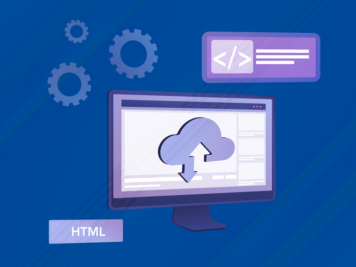Software development is undergoing a major overhaul. Gone are the days when programmers worked in isolation on endless lines of code for hours at a stretch. Artificial intelligence is the new co-pilot, and it is transforming software development processes. According to GitHub, around 92% of developers are currently using AI code generators to deal with severe workloads. These AI-powered tools significantly accelerate software solution delivery while reducing errors in code production.
GitHub Copilot has built a niche for itself among all the AI tools out there. It saves time and effort and improves overall code quality by suggesting relevant code based on the given context. But can it be the go-to coding partner?
The answer involves reviewing its capabilities, walking through its setup, and understanding how Copilot generates code suggestions. As a Senior Software Developer, I had the opportunity to gain firsthand insights by testing Copilot for projects. This experience not only deepened my understanding but also revealed its limitations and considerations. But before diving deeper, let’s first decode the basics.
What is GitHub Copilot
GitHub teamed up with OpenAI to build this AI-powered code completion tool with an aim to help developers by providing code suggestions within their integrated development environment (IDE).
GitHub Copilot uses ML models trained on a large amount of open-source code for intelligent code suggestions while typing. OpenAI’s GPT-3 language model has been fine-tuned for programming tasks to build this tool.
Capabilities of Copilot:
GitHub Copilot is designed to enhance developer productivity by enabling faster code writing with less effort. This allows developers to focus more on problem-solving and innovation. With a range of features, Copilot ensures that developers can maximize its benefits.
1. Code Autocompletion: Copilot can suggest entire lines or blocks of code based on the context of the current codebase and the developer’s task, automating repetitive or boilerplate code.
2. Natural Language Understanding: Interaction with Copilot using natural language comments or descriptions is easy. For example, users can describe a function or a complex algorithm in plain English, and Copilot will generate the corresponding code.
3. Language Support: GitHub Copilot supports a wide range of programming languages, including many popular ones like Python, JavaScript, C++, Java, and many others. This makes it versatile for developers working across different tech stacks.
4. Context-Aware Suggestions: Copilot understands the context of the written code, including variable names, function definitions, and common coding patterns. It adapts its suggestions based on the specific programming language syntax and conventions.
5. Integration with IDEs: Copilot integrates seamlessly with popular IDEs such as Visual Studio Code (VS Code) and JetBrains IntelliJ IDEA through extensions. This enables developers to use Copilot directly within their familiar coding environment.
6. Learning and Adaptation: Over time, Copilot learns from user interactions and feedback. It improves its suggestions based on how developers use the generated code and the corrections they make, making it more accurate and effective.
Setting Up GitHub Copilot
VS code:
GitHub Copilot primarily integrates with Visual Studio Code (VS Code) as its primary IDE. Below is a step-by-step solution for setting up:
- Install Visual Studio Code (VS Code): If you don’t have VS Code installed, you can download it from the official VS Code website.
- Install GitHub Copilot Extension in VS Code:
- Open VS Code
- Go to the Extensions view by clicking on the Extensions icon in the Activity Bar on the side of the window or by pressing Ctrl+Shift+X.
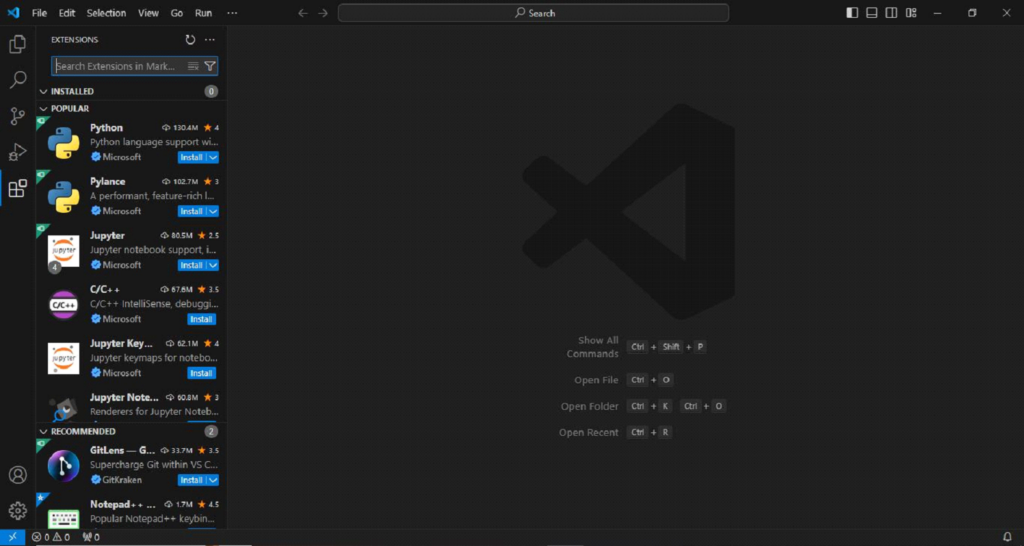
⦁ Search for “GitHub Copilot” in the Extensions
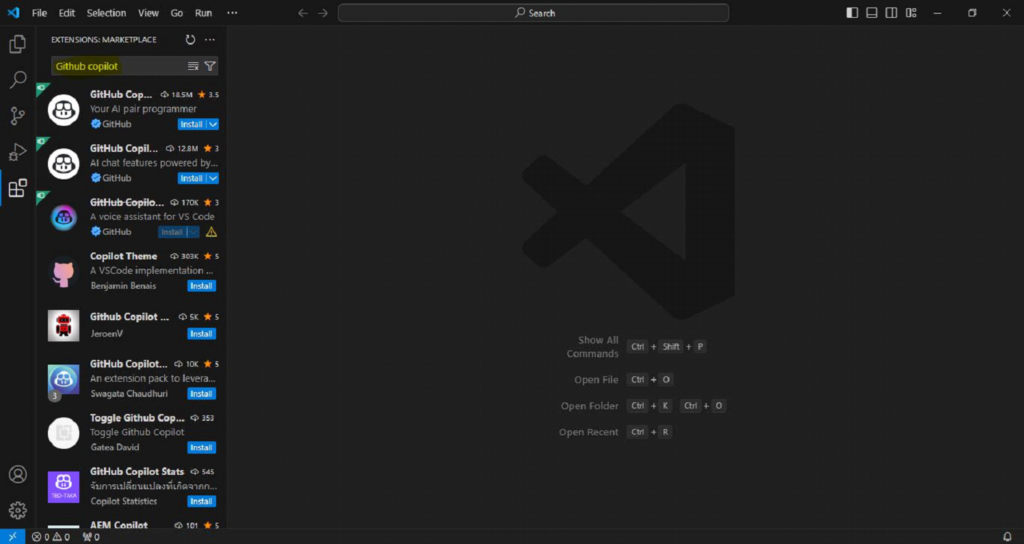
⦁ Click Install to install the GitHub Copilot extension.
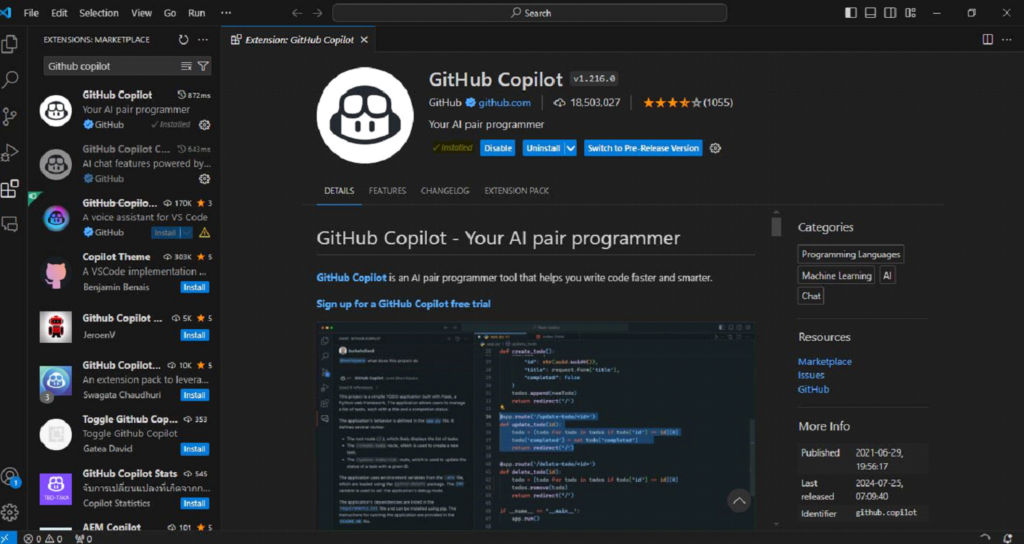
IntelliJ IDEA:
- Install Intellij Idea: If you don’t have Intellij Idea installed, you can download it from the official Jetbrains website.
- *Community version is free.
Install GitHub Copilot Plugin in Intellij idea:
- Open Intellij Idea.
- Go to the File > Settings or press Ctrl+Alt+S > Plugin.
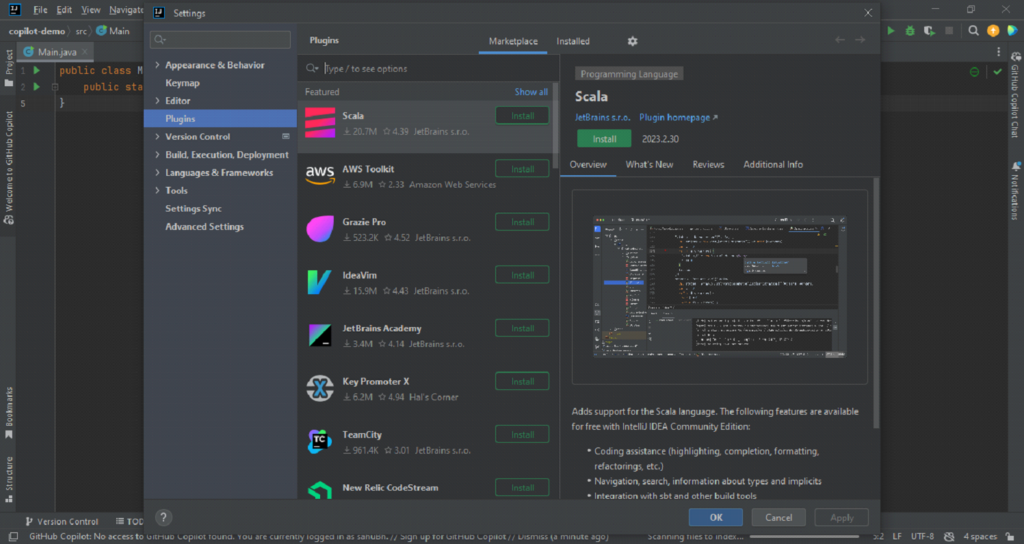
- Search for “GitHub Copilot” in the Plugin Marketplace.
- Click Install to install the GitHub Copilot extension.
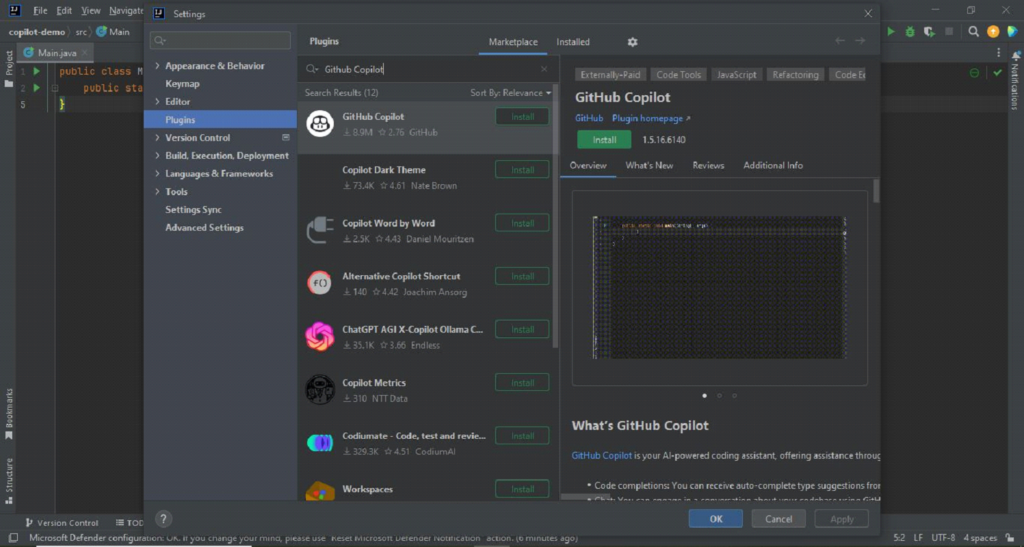
- Restart the IDE
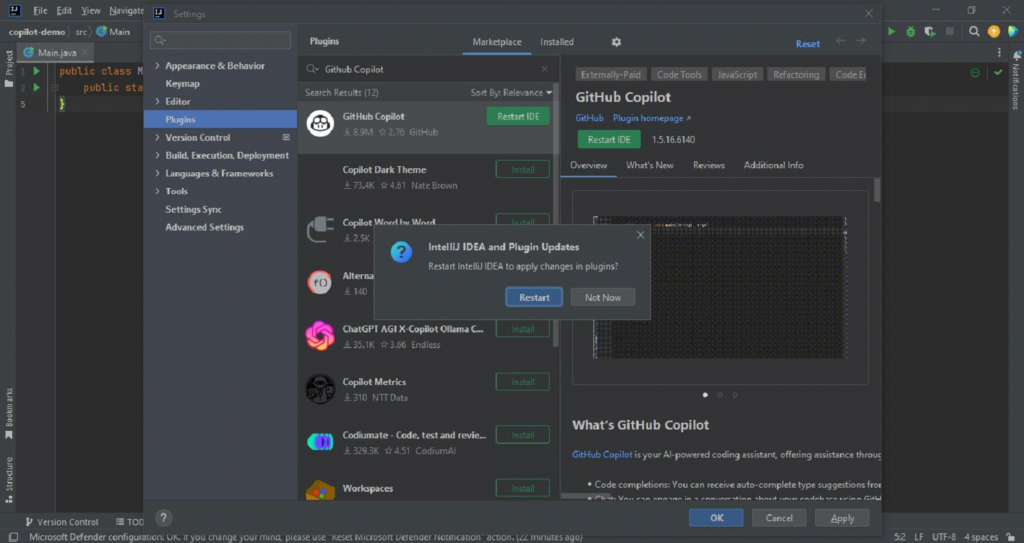
Link GitHub Copilot with Your GitHub Account: After installing the extension/plugin , you’ll need to link GitHub Copilot with your GitHub account. Follow the prompts in VS Code/Intrllij IDE to sign in with your GitHub account.
- Click on Sign in to Github, note the device code shown as you’ll need it later, click Copy and Open.
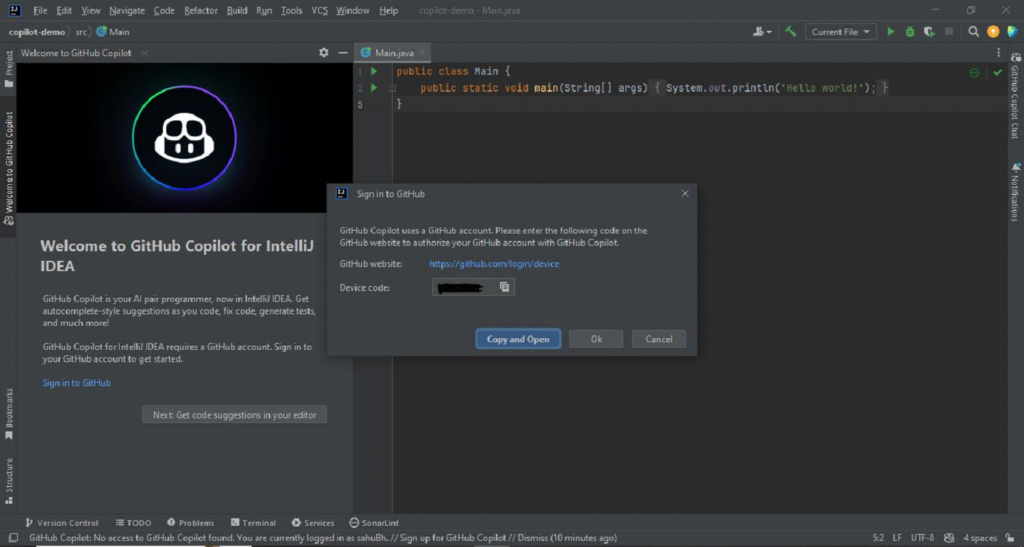
- In device activation, if you are already logged in to your Github account, it will list your Github username; otherwise, it will ask you to login your Github account. After selecting your Github account click Continue.

- Enter the device code displayed in Step 1; you’ll get page to Authorize Github Copilot plugin

- After Authorization Github Copilot will be integrated with the IDE

- Once installed, Copilot begins generating suggestions. Let’s explore how.
How Copilot generates code suggestions
GitHub Copilot generates code suggestions using a combination of advanced machine-learning models and a vast dataset of publicly available code from GitHub repositories. Here’s a simplified overview of how Copilot generates these suggestions:
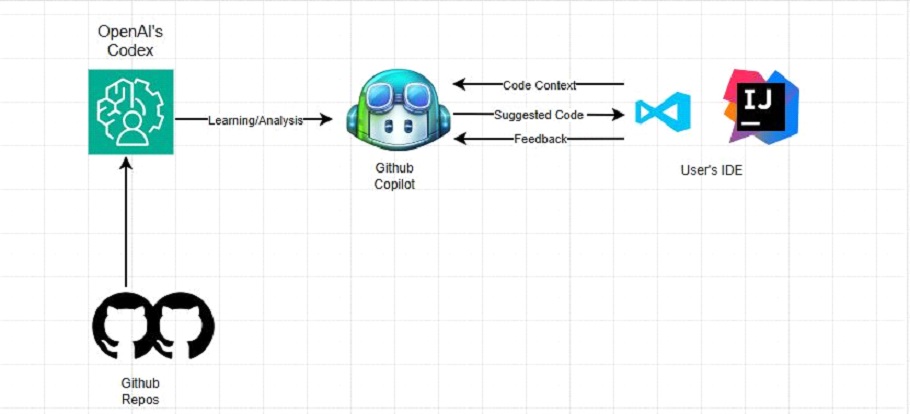
1. Machine Learning Model: GitHub Copilot is powered by OpenAI’s Codex powered by GPT-3 (Generative Pre-trained Transformer 3) language model. Codex has been specifically fine-tuned on a large amount of code from GitHub, making it adept at understanding and generating programming code.
2. Contextual Understanding: When a user starts typing or providing a prompt in natural language, Copilot uses its language model to understand the context and intent behind the request. It analyzes the text to determine what kind of code snippet would best fit the context.
3. Code Repository Knowledge: Copilot has been trained on a diverse range of programming languages and coding styles found in GitHub repositories. It learns from this data to generate code that adheres to common programming patterns, conventions, and best practices.
4. Adaptation and Feedback: As developers use Copilot and provide feedback on the suggestions, the model learns and adapts. It improves its ability to provide accurate and relevant code suggestions over time based on user interactions.
5. Real-time Suggestions: When developers type, Copilot generates real-time code suggestions that appear directly in their IDE. These suggestions can range from completing variable names and function definitions to generating entire blocks of code based on the context provided.
6. Verification and Correction: While Copilot aims to generate accurate code, developers must verify and review the suggestions. This ensures that the generated code meets their project’s specific requirements and adheres to their coding standards.
Copilot’s code generation is awesome, but it can be enhanced further by adhering to some of these best practices.
Some Best Practices
1. Provide clear context: Write clear and descriptive comments or code that outlines what you want to achieve. This helps Copilot generate more relevant suggestions.
2. Use descriptive variables and function names: Meaningful names help Copilot understand the context better and suggest more appropriate code snippets. Users should always describe the functionality or logic in simple English to let Copilot generate the corresponding code.
3. Review and Refine Suggestions: Reviewing the code Copilot suggests is a must. It might need adjustments or corrections, especially for complex logic or domain-specific needs.
4. Leverage Code Comments: Best way to do it is by starting the code or comments with specific goals or requirements. For example, // function to find max number in a list of numbers can guide Copilot to generate the appropriate code
5. Use Different Prompting Styles: If Copilot’s suggestions are not as expected, developers should try rephrasing their comments or code. They should experiment with different ways of describing what they need.
6. Combine with Manual Coding: Copilot is a supplementary tool rather than a replacement for manual coding. It’s best used to speed up repetitive tasks.
7. Check for Security: Copilot might suggest code that is not secure. Ensure that the generated code adheres to current security guidelines.
While best practices can optimize Copilot’s performance, GitHub Copilot comes with its own limitations understanding which is equally important for its effective use.
Limitations and Considerations
1. Limited Understanding: Copilot might not fully understand the context or specific requirements of the project, leading to suggestions that may not always be accurate or relevant.
2. Error-prone Suggestions: It can sometimes generate code with errors, bugs, or logical flaws.
3. Security Vulnerabilities: Copilot might suggest code that introduces security vulnerabilities or uses outdated practices. It’s crucial to vet the suggestions for security issues and adhere to best practices.
4. Tool Compatibility: Copilot may not seamlessly integrate with all development environments or tools.
5. Code Copyrights: Since Copilot is trained on publicly available code, there might be concerns about code licensing and the originality of suggestions. It can lead to legal disputes later.
6. No Debugging: Copilot does not assist with debugging or troubleshooting. If the generated code has issues, developers should rely on their debugging skills or tools.
7. Language: As of now Copilot only understands English language so all the prompts should be in English only.
Conclusion
GitHub Copilot can significantly enhance pair programming by speeding up development, promoting collaboration, and improving code quality. It boosts productivity by automating routine tasks, offering intelligent code suggestions, and allowing developers to focus on higher-level design and problem-solving. Powered by advanced machine learning and extensive training on real-world code, Copilot provides AI-driven assistance to automate coding and explore new solutions.
However, the code it generates may not always be correct or cover all edge cases, so thorough code review and testing are essential. Considering the modern trend and future scope of AI Github Copilot will definitely have a promising future.
Additional Resources
Interested in learning Github Copilot, refer the resources



